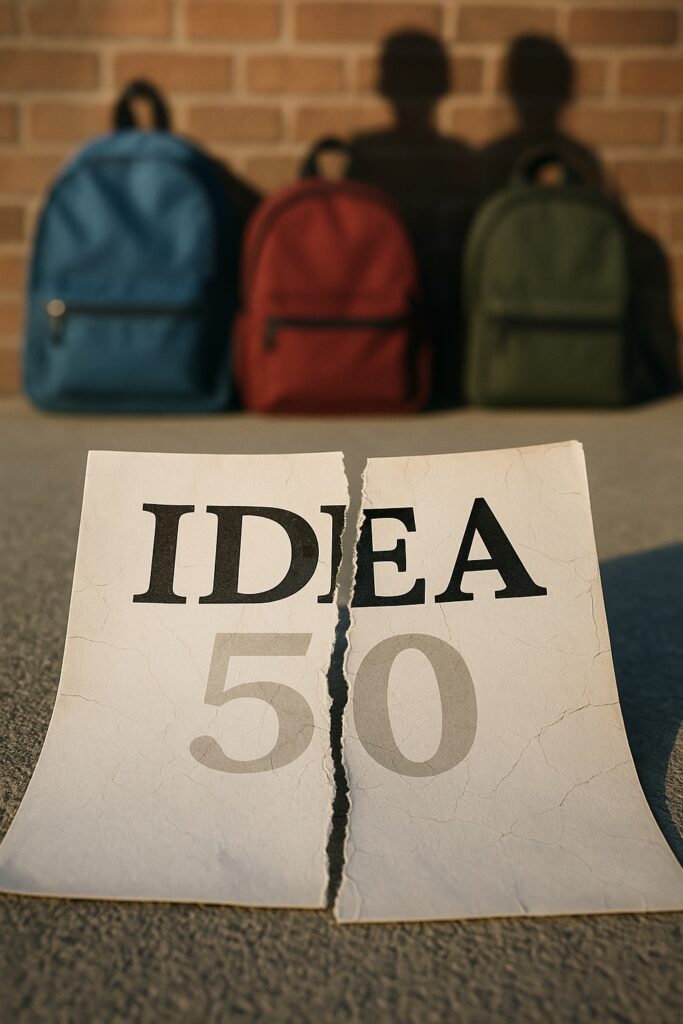Fifty years ago, the United States did something rare: it made a moral commitment to children that actually meant something. When Congress passed the Education for All Handicapped Children Act on November 29, 1975 — the law that later became IDEA — it drew a line in the sand:
- No more shutting disabled children out of school.
- No more institutionalization as destiny.
- No more telling parents: “You’re on your own.”
Before IDEA, conditions weren’t just inadequate — they were brutal. Disabled children were routinely excluded from public education. Families were told their kids “didn’t belong” or “couldn’t learn.” Institutions overflowed with children who were isolated, restrained, or warehoused. Education was considered a courtesy, not a right.
IDEA ended that era. Or at least, it was supposed to.

We may mark the 50th anniversary as progress — and it is — but anniversaries are also evaluations. And right now, IDEA is being quietly hollowed out. Not by repeal, not by public debate, but by something far more dangerous:
Neglect, obstruction, and the systematic dismantling of enforcement.
A promise without enforcement is just paperwork. And families know it.
The Promise vs. the Reality — What Families Know Too Well
I’m not writing this as a policy analyst. I’m writing this as a father who has lived the gap between IDEA’s promise and IDEA’s practice.
Stone never needed IDEA to grant him intelligence. He needed IDEA to grant him access.
And even with a law behind us, our journey has been a battlefield of:
- Chronic underestimation from professionals who believed they understood him better than he understood himself.
- Constant delays disguised as “caution” or “data collection.”
- Administrators questioning whether a nonspeaking autistic student could possibly comprehend the world around him.
- A system so tangled that unless a family has resources — legal, financial, emotional — the school wins through delay alone.
Most Americans don’t realize it, but IDEA is one of the most violated civil rights laws in the country. And the families who need it most often have the least power to enforce it.
Our family refused to give up. But that shouldn’t be a prerequisite for receiving a free and appropriate public education.
IDEA Turns 50 at the Weakest Moment in Decades
The NEA’s anniversary reflection makes it clear: IDEA changed everything. Children once shut out are now in classrooms, colleges, and careers.
But celebration without accountability is dangerous. And right now, IDEA is in the most fragile condition it has been in decades.
Here is the truth:
1. Enforcement is collapsing.
The Office for Civil Rights and Department of Justice — the agencies responsible for protecting disabled students — are stepping back. Cases are dropped. Complaints go unanswered. Violations go unchecked.
A civil rights law without enforcement is nothing more than a suggestion.
2. Funding is inconsistent and inadequate.
IDEA was supposed to be funded at 40%. It has never reached that level.
Districts fill the gap by cutting corners, denying services, or rationing resources. Underfunding doesn’t just generate inequity — it guarantees inequity.
And the hardest-hit students are consistently Black, Latino, Indigenous, immigrant, and low-income disabled children.
3. The attack on communication rights is intensifying.
Students using AAC, S2C, or Augmented Cognitive Communication (ACC) are routinely denied access because schools lean on ASHA’s outdated, scientifically unsupported stance.
Districts treat motor disability as cognitive disability.
- They dismiss communication methods they don’t understand.
- They ignore modern research on apraxia and motor planning.
This is a quiet war — and it is happening under IDEA’s umbrella.
4. Policy rollbacks are already harming students.
In the past year alone:
- Deafblind education grants were abruptly canceled mid-cycle.
- Special education teacher training funds were slashed.
- Communication access initiatives were deprioritized.
- Federal civil rights oversight weakened.
All of these cuts share a common thread:
They withdraw support from the very children IDEA was designed to protect.
Progress Is Not Fulfillment
Yes, we’ve come a long way from the days when disabled children were turned away at schoolhouse doors. But progress is not permanent — and it is not self-sustaining.
Stone’s journey shows what becomes possible when competence is presumed, communication is supported, and rights are respected. His intelligence, creativity, and leadership reflect a young man who was always there — just waiting for access.
For every Stone, there are hundreds of thousands stuck in systems that don’t believe in them, don’t listen to them, and don’t understand what they’re capable of.
Rights erode quietly when people assume someone else is safeguarding them.
This Anniversary Is Not a Celebration — It’s a Warning
IDEA turns 50 at a time when disabled students need protection more than ever — yet the very institutions meant to uphold their rights are pulling away.
And it’s important to note: despite talking publicly about autism, RFK Jr. has introduced no federal proposals, programs, or protections that materially benefit autistic individuals or disabled students within HHS. Visibility is not advocacy, especially when the visibility reinforces the wrong priorities and distracts from real solutions.
So here’s the call:
We cannot let IDEA’s 50th anniversary become the year its protections begin to disappear yet again.
We cannot drift back toward the pre-1975 era — the one too many have forgotten, and too many children would not survive. This is not making America healthy – nor “great” again.
Communication is a human right.
Inclusion is a human right.
Presuming competence is a moral minimum.
Disabled children are not burdens or budget lines.
They are human beings with futures we are legally and ethically obligated to protect.
Fifty years ago, the nation said: Every child deserves an education.
Today, the question is whether we still mean it.
We cannot — must not — be silent.
